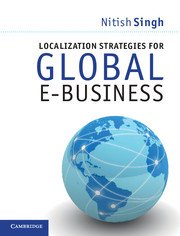Book contents
- Frontmatter
- Contents
- Figures
- Tables
- Preface
- Illustration credits and acknowledgements
- 1 Global e-commerce opportunities and challenges
- 2 International e-business expansion and market entry strategies
- 3 Global online consumer segmentation
- 4 Web globalization strategies
- 5 Developing international websites: internationalization
- 6 Effectively localizing international websites
- 7 Managing a web globalization value chain
- 8 Optimizing international websites
- 9 Assessing web globalization efforts
- 10 Strategic industry insights and emerging localization trends
- Web globalization resources
- Index
- References
7 - Managing a web globalization value chain
Published online by Cambridge University Press: 05 June 2012
- Frontmatter
- Contents
- Figures
- Tables
- Preface
- Illustration credits and acknowledgements
- 1 Global e-commerce opportunities and challenges
- 2 International e-business expansion and market entry strategies
- 3 Global online consumer segmentation
- 4 Web globalization strategies
- 5 Developing international websites: internationalization
- 6 Effectively localizing international websites
- 7 Managing a web globalization value chain
- 8 Optimizing international websites
- 9 Assessing web globalization efforts
- 10 Strategic industry insights and emerging localization trends
- Web globalization resources
- Index
- References
Summary
The value chain concept
A critical part of the development, deployment, and maintenance of international websites is ensuring that web globalization is managed effectively. Previous chapters delved into concepts related to both the back-end and the front-end management of international websites. This chapter takes a look at the processes involved in integrating and managing all web globalization activities in a coherent and efficient manner.
The concept of a value chain can help companies evaluate how various web globalization processes complement and integrate with each other. The basic idea of the value chain concept, which was first introduced by well-known management guru Michael Porter (1985), is that raw material comes into the company and passes through various value-adding steps that transform it into a final product that is delivered to satisfy customer needs. Value chain analysis involves first charting then analyzing the various value-creating activities in the web globalization process. Organizations use this process to identify value-creating activities and then to prioritize them within the organizational workflow.
In Porter’s description of a value chain, the “primary activities” in the value chain include inbound logistics, production/operations, outbound logistics, marketing and sales, and services (see Figure 7.1); the “support activities” include administrative infrastructure management, human resource management, information technology, and procurement. However, in the context of web globalization, I would not classify IT as a support activity.
Information
- Type
- Chapter
- Information
- Localization Strategies for Global E-Business , pp. 183 - 212Publisher: Cambridge University PressPrint publication year: 2011
